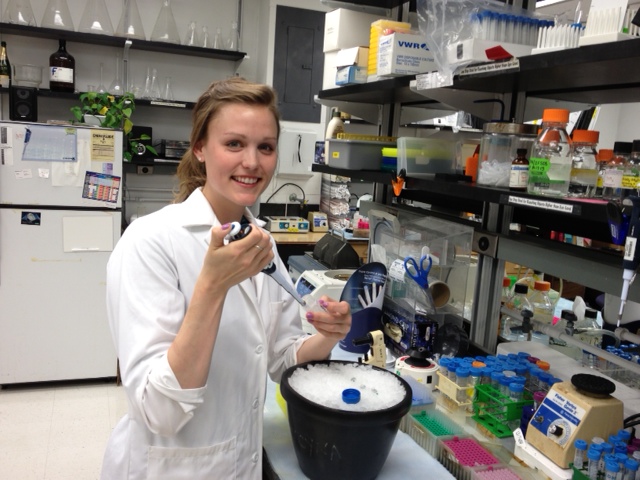
Amy Funk

Training Group:
Membrane Biology
Mentor / Lab:
Dr. Christine Hrycyna
Specific Research Area / Project:
Characterization of the Substrate Binding Site of Isoprenyclysteine Carboxyl Methylstransferase and Targeted Inhibition to Improve Curren Chemotherapeutics
Undergraduate Institution:
The University of Minnesota
Research Profile:
CaaX proteins undergo three sequential post-translational modifications: isoprenylation of the cysteine residue, endoproteolysis of the –aaX residues and methylation of the isoprenylated cysteine by isoprenylcysteine carboxyl methyltransferase (Icmt). The most notable is K-Ras that is mutated in approximately 30% of all cancers and 90% of pancreatic cancer. We are focusing on the structure and function of Ste14p, the Icmt from S. cerevisiae, as a model for the human enzyme. As methylation is critical for proper localization of K-Ras in humans and may be essential for oncogenic transformation, Icmt may prove to be an excellent chemotherapeutic target. Utilizing site-directed mutagenesis and synthetic analogs of minimal substrates containing photoactive benzophenone or diazirine moieties, we have successfully identified regions of Ste14p that are implicated in substrate binding. We are now poised to understand in mechanistic detail how Ste14p mediates catalysis of the co-factor S-adenosylmethionine and an isoprenylated substrate.
Life After PULSe:
Current position: Postdoctoral Fellow at the National Cancer Institute (NCI) in Frederick, MD | National Institutes of Health (NIH)
Department: Signaling Networks in Cancer Section | Laboratory of Cell and Developmental Signaling (LCDS) | Center for Cancer Research (CCR)
Mentor: John Brognard, Ph.D.
I am a postdoctoral fellow at the National Cancer Institute (NCI) in Dr. John Brognard’s laboratory. I am investigating an understudied kinase called leucine zipper-bearing kinase (LZK) in head and neck squamous cell carcinoma (HNSCC). Our data indicates LZK as a promising therapeutic target for HNSCC patients. Currently, we are testing specific inhibitors in xenograft and PDX mouse models before moving to the clinic. As a past graduate student in the PULSe program, I learned many valuable research techniques and model systems during my four 8-week rotations and from the laboratory I joined in the Chemistry department. This knowledge has helped my current research projects progress quickly. Also, I was able to learn how to become an independent scientist at Purdue which has allowed me to thrive as a postdoctoral fellow at the NIH.
In addition to my research, I am also involved in the NIH community. During my first year at the NCI, I became involved in the Center for Cancer Research Fellows and Young Investigators (CCR-FYI) association. Last year I was voted into the Vice-chair position to help plan the CCR-FYI’s Annual Colloquium. During the two day event, we scheduled intramural and extramural scientists to speak about their research to postdocs, postbacs, and graduate students at the NCI. Additionally, we had workshops, panels, and poster sessions throughout the two day event. Starting this June, I will be the Chair for planning the 2020 Colloquium. My involvement at the NIH was motivated by the great experiences I had as a part of the PULSe graduate student organization (GSO) at Purdue. As a result, I joined the FYI association at the start of my fellowship. This association has been very beneficial by increasing my networking circle and learning professional skills outside of the laboratory. Overall, PULSe was an outstanding interdisciplinary graduate program and it will definitely help any student succeed in their future career path.
Awards:
- Women in Science Travel Grant (Awarded Spring 2013)
- PULSe Travel Grant (Awarded Spring 2013)
- PULSe Graduate Student Organization Officer Certificate of Appreciation (Awarded Spring 2013)
- First-Year Mentoring Program Certificate of Appreciation (Awarded Spring 2013)
- Science in Schools Certificate of Recognition (Awarded Spring 2013)
- Science in Schools Certificate of Recognition (Awarded Spring 2012)
- PULSe Fellowship (Fall 2011 to Summer 2012)
Presentations:
- Amy L. Funk, Kalub Hahne, Jeffery Vervacke, Richard Gibbs, Mark Distefano, and Christine Hrycyna. “Elucidation and Targeted Inhibition of the Substrate Binding Site of Isoprenylcysteine Carboxyl Methyltransferase” The Office of Interdisciplinary Graduate Programs (OIGP) Poster Presentation, Purdue University, West Lafayette, IN (Spring 2013)
- Christine Hrycyna. “Membrane Proteins: Cancer Therapeutics and Drug Delivery” Spring PULSe Recruitment Poster Presentation, Purdue University, West Lafayette, IN (Spring 2013)
Leadership:
- American Chemical Society Member (Spring 2013-Present)
- Iota Sigma Pi National Honor Society For Women in Chemistry (Spring 2012-Present)
- PULSe Graduate Student Organization Secretary Officer (Summer 2012-Present)
- First-Year Mentoring Program (Fall 2012-Present)
- Volunteer with Science in Schools/Science Night Programs (Fall 2011-Present)
- Women in Science Member (Fall 2011-Present)

